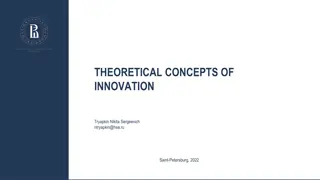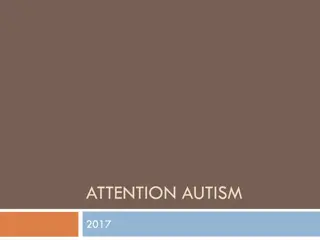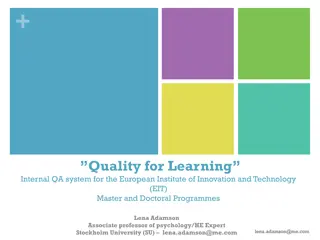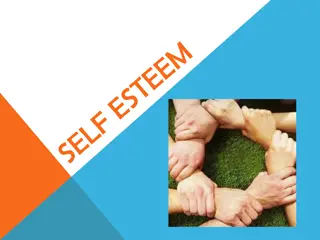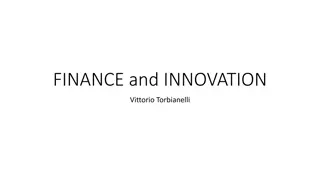Self-Attention: A Key Model Innovation
Recurrent neural networks have long been dominant in sequence modeling, but recent advancements in attention mechanisms have led to the emergence of the Transformer model. By focusing on global dependencies without recurrence, the Transformer enables high parallelization and achieves state-of-the-art results in translation tasks. This shift in architecture offers significant computational efficiency and improved model performance.
Download Presentation

Please find below an Image/Link to download the presentation.
The content on the website is provided AS IS for your information and personal use only. It may not be sold, licensed, or shared on other websites without obtaining consent from the author.If you encounter any issues during the download, it is possible that the publisher has removed the file from their server.
You are allowed to download the files provided on this website for personal or commercial use, subject to the condition that they are used lawfully. All files are the property of their respective owners.
The content on the website is provided AS IS for your information and personal use only. It may not be sold, licensed, or shared on other websites without obtaining consent from the author.
E N D
Presentation Transcript
ATTENTION IS ALL YOU NEED ASHISH VASWANI NOAM SHAZEER NIKI PARMAR JAKOB USZKOREIT LLION JONES AIDAN N. GOMEZ UKASZ KAISER ILLIA POLOSUKHIN
OUTLINE Instruction Background Model Why Self-Attention Training Result Conclusion
INSTRUCTION Recurrent neural networks, long short-term memory and gated recurrent neural networks in particular, have been firmly established as state of the art approaches in sequence modeling and transduction problems such as language modeling and machine translation.
INSTRUCTION Recurrent models typically factor computation along the symbol positions of the input and output sequences. Aligning the positions to steps in computation time. Recent work has achieved significant improvements in computational efficiency through factorization tricks and conditional computation. The fundamental constraint of sequential computation, however, remains.
INSTRUCTION Attention mechanisms have become an integral part of compelling sequence modeling and transduction models in various tasks, allowing modeling of dependencies without regard to their distance in the input or output sequences. In this work we propose the Transformer, a model architecture eschewing recurrence and instead relying entirely on an attention mechanism to draw global dependencies between input and output. The Transformer allows for significantly more parallelization and can reach a new state of the art in translation quality after being trained for as little as twelve hours on eight P100 GPUs.
BACKGROUND The goal of reducing sequential computation also forms the foundation of the Extended Neural GPU,ByteNet and ConvS2S, all of which use convolutional neural networks as basic building block, computing hidden representations in parallel for all input and output positions. In these models, the number of operations required to relate signals from two arbitrary input or output positions grows in the distance between positions, linearly for ConvS2S and logarithmically for ByteNet. In the Transformer this is reduced to a constant number of operations, albeit at the cost of reduced effective resolution due to averaging attention-weighted positions, an effect we counteract with Multi-Head Attention.
BACKGROUND Self-attention is an attention mechanism relating different positions of a single sequence in order to compute a representation of the sequence. Self-attention has been used successfully in a variety of tasks including reading comprehension, abstractive summarization, textual entailment and learning task- independent sentence representations.
BACKGROUND End-to-end memory networks are based on a recurrent attention mechanism instead of sequence aligned recurrence and have been shown to perform well on simple-language question answering and language modeling tasks. The Transformer is the first transduction model relying entirely on self-attention to compute representations of its input and output without using sequence aligned RNNs or convolution.
MODEL-ATTENTION An attention function can be described as mapping a query and a set of key-value pairs to an output, where the query, keys, values, and output are all vectors. The output is computed as a weighted sum of the values, where the weight assigned to each value is computed by a compatibility function of the query with the corresponding key.
MODEL-SCALED DOT-PRODUCT ATTENTION Input 1. q:query 2. k:key 3. v:value 4. dimension->query,key:??;value:?? ??? ?? ????????? ?,?,? = ??????? ?
MODEL-MULTI-HEAD ATTENTION Multi-head attention allows the model to jointly attend to information from different representation subspaces at different positions. With a single attention head, averaging inhibits this. ????????? ?,?,? = ?????? ???1, , ??? ?? ?,????,????) Where ????= ?????????(??? the projections are parameter matrices ??? ?????? ??,??? ?????? ??,??? ?????? ??and WO ?? ?????? In this work we employ = 8 parallel attention layers, or heads. For each of these we use ??= ??= ??????/ = 64. Due to the reduced dimension of each head, the total computational cost is similar to that of single-head attention with full dimensionality.
MODEL The Transformer follows this overall architecture using stacked self-attention and point- wise, fully connected layers for both the encoder and decoder.
MODEL-ADD&NORM The output of each sub-layer is ?????????(? + ????????(?)), where ????????(?) is the function implemented by the sub-layer itself. To facilitate these residual connections, all sub-layers in the model, as well as the embedding layers, produce outputs of dimension ??????= 512.
MODEL-POSITION-WISE FEED-FORWARD NETWORKS In addition to attention sub-layers, each of the layers in our encoder and decoder contains a fully connected feed-forward network, which is applied to each position separately and identically. This consists of two linear transformations with a ReLU activation in between. ??? ? = max 0,??1+ ?1 ?2+ ?2 this is as two convolutions with kernel size 1. The dimensionality of input and output is ??????= 512, and the inner-layer has dimensionality ???= 2048.
MODEL-ENCODER The encoder is composed of a stack of N = 6 identical layers. Each layer has two sub- layers. The first is a multi-head self-attention mechanism, and the second is a simple, positionwise fully connected feed-forward network. We employ a residual connection around each of the two sub-layers, followed by layer normalization.
MODEL-DECODER The decoder is also composed of a stack of N = 6 identical layers. In addition to the two sub-layers in each encoder layer, the decoder inserts a third sub-layer, which performs multi-head attention over the output of the encoder stack. We modify the self-attention sub-layer in the decoder stack to prevent positions from attending to subsequent positions. This masking, combined with fact that the output embeddings are offset by one position, ensures that the predictions for position i can depend only on the known outputs at positions less than i.
MODEL-EMBEDDINGS AND SOFTMAX We use learned embeddings to convert the input tokens and output tokens to vectors of dimension dmodel. We also use the usual learned linear transformation and softmax function to convert the decoder output to predicted next-token probabilities. We share the same weight matrix between the two embedding layers and the pre- softmax linear transformation. In the embedding layers, we multiply those weights by ??????.
MODEL-POSITIONAL ENCODING Add "positional encodings" to the input embeddings at the bottoms of the encoder and decoder stacks. The positional encodings have the same dimension dmodel as the embeddings, so that the two can be summed. We use sine and cosine functions of different frequencies: 1. ??(???,2?)= sin(???/100002?/??????) 2. ??(???,2?+1)= cos(pos/100002?/??????) pos is the position and i is the dimension. The wavelengths form a geometric progression from 2? ?? 10000 2?. Since for any fixed offset ?, ?????+?can be represented as a linear function of ?????.
TRAINING trained on the standard WMT 2014 English-German dataset consisting of about 4.5 million sentence pairs shared sourcetarget vocabulary of about 37000 tokens. 2014 English-French dataset consisting of 36M sentences and split tokens into a 32000 word-piece vocabulary Each training batch contained a set of sentence pairs containing approximately 25000 source tokens and 25000 target tokens.
TRAINING Optimizer:adam ?1= 0.9,?2= 0.98,? = 10 9 0.5 min(????_???0.5,????_??? ??????_?????1.5) ????? = ?????? This corresponds to increasing the learning rate linearly for the first warmup_steps training steps, and decreasing it thereafter proportionally to the inverse square root of the step number. ??????_????? = 4000.
TRAINGING Residual Dropout We apply dropout to the output of each sub-layer, before it is added to the sub-layer input and normalized. In addition, we apply dropout to the sums of the embeddings and the positional encodings in both the encoder and decoder stacks. For the base model, we use a rate of ????? = 0.1. Label Smoothing During training, we employed label smoothing of ????? ???= 0.1. This hurts perplexity, as the model learns to be more unsure, but improves accuracy and BLEU score.
CONCLUSION replacing the recurrent layers most commonly used in encoder-decoder architectures with multi-headed self-attention For translation tasks, the Transformer can be trained significantly faster than architectures based on recurrent or convolutional layers. plan to extend the Transformer to problems involving input and output modalities other than text and to investigate local, restricted attention mechanisms to efficiently handle large inputs and outputs such as images, audio and video.




